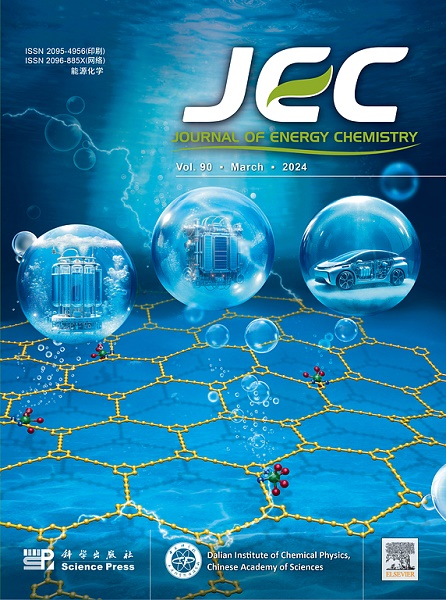Asymmetric ionomer configuration in membrane electrode assembly for enhanced water management and performance in anion exchange membrane fuel cells
IF 13.1
1区 化学
Q1 Energy
引用次数: 0
Abstract
Anion exchange membrane fuel cells (AEMFCs) are considered a more affordable technology compared to proton exchange membrane fuel cells (PEMFCs), but the performance and durability of AEMFCs are still not competent with PEMFCs owing to the more challenging water management, which severely hinders its development and real-life applications. In this study, we introduce the strategy to boost the performance and stability of the membrane electrode assembly (MEA) of AEMFCs by regulating the hydrophilicity of the anode and cathode ionomers. Two poly(biphenyl alkylene) ionomers with different hydrophilicity are synthesized and used to fabricate MEAs with asymmetric or symmetric ionomer configurations in the anodic and cathodic catalyst layers (CLs) for AEMFCs. Molecular dynamics (MD) simulations have revealed different diffusion rates of water in the hydrophobic anode and the hydrophilic cathode, which show the potential of this design to improve water management in AEMFCs. The effectiveness of this design is also confirmed by experimental results that the MEA with this asymmetric configuration exhibits the highest power and current densities of 1.58 W cm−2 or 5.58 A cm−2, respectively, among all configurations. Furthermore, this configuration also enhances the durability, with the MEA showing a voltage decay rate of only 313.1 μV h−1 after 500 h of in-situ durability test at 0.2 A cm−2. This study provides new insights into the rational design of more efficient water management in MEA for high-performance AEMFCs.

求助全文
约1分钟内获得全文
求助全文
来源期刊

Journal of Energy Chemistry
CHEMISTRY, APPLIED-CHEMISTRY, PHYSICAL
CiteScore
19.10
自引率
8.40%
发文量
3631
审稿时长
15 days
期刊介绍:
The Journal of Energy Chemistry, the official publication of Science Press and the Dalian Institute of Chemical Physics, Chinese Academy of Sciences, serves as a platform for reporting creative research and innovative applications in energy chemistry. It mainly reports on creative researches and innovative applications of chemical conversions of fossil energy, carbon dioxide, electrochemical energy and hydrogen energy, as well as the conversions of biomass and solar energy related with chemical issues to promote academic exchanges in the field of energy chemistry and to accelerate the exploration, research and development of energy science and technologies.
This journal focuses on original research papers covering various topics within energy chemistry worldwide, including:
Optimized utilization of fossil energy
Hydrogen energy
Conversion and storage of electrochemical energy
Capture, storage, and chemical conversion of carbon dioxide
Materials and nanotechnologies for energy conversion and storage
Chemistry in biomass conversion
Chemistry in the utilization of solar energy
 求助内容:
求助内容: 应助结果提醒方式:
应助结果提醒方式:


